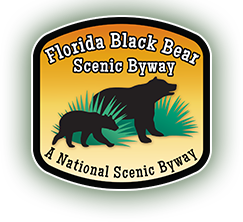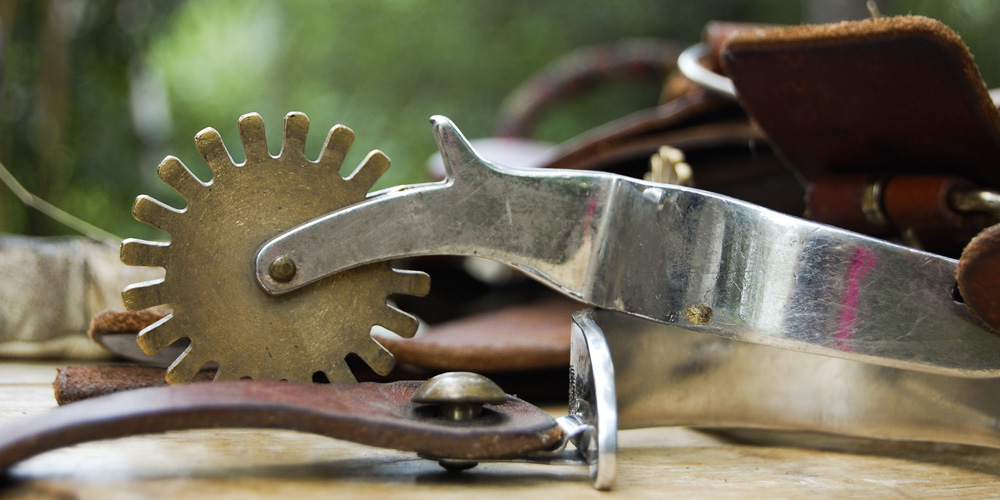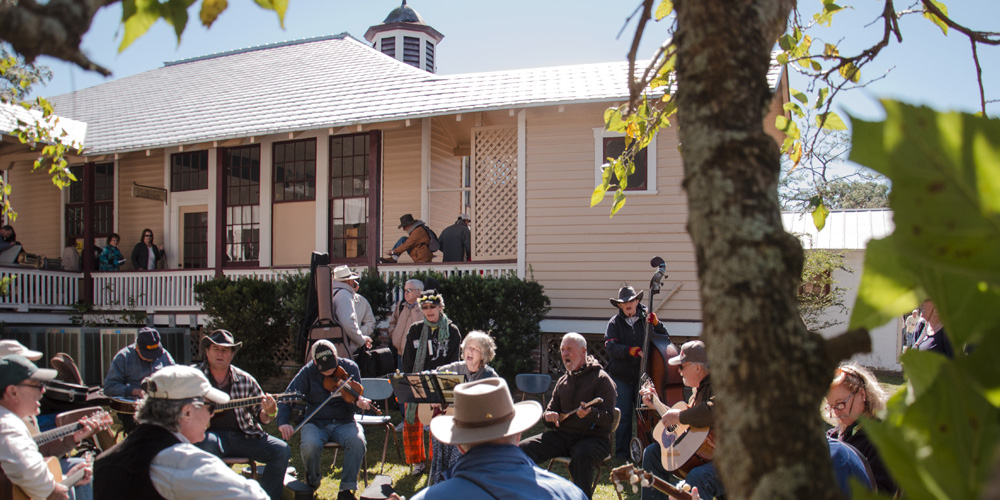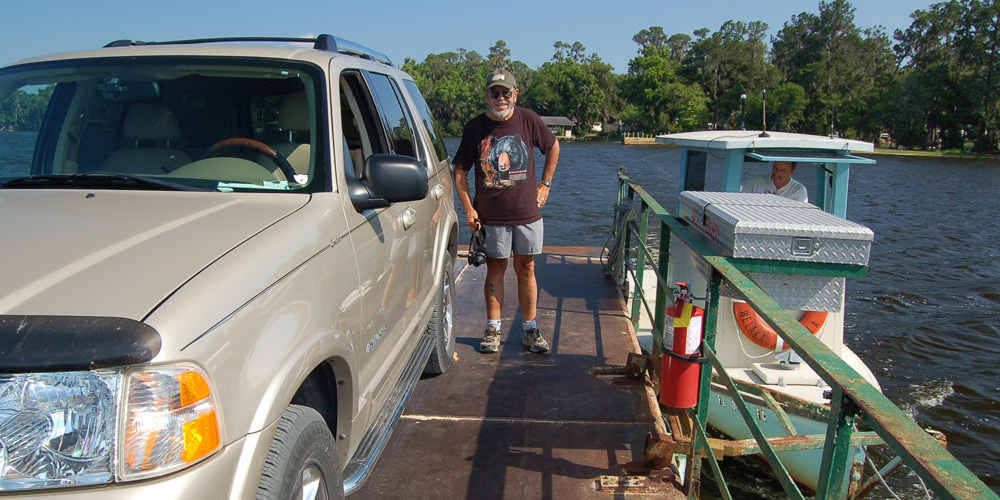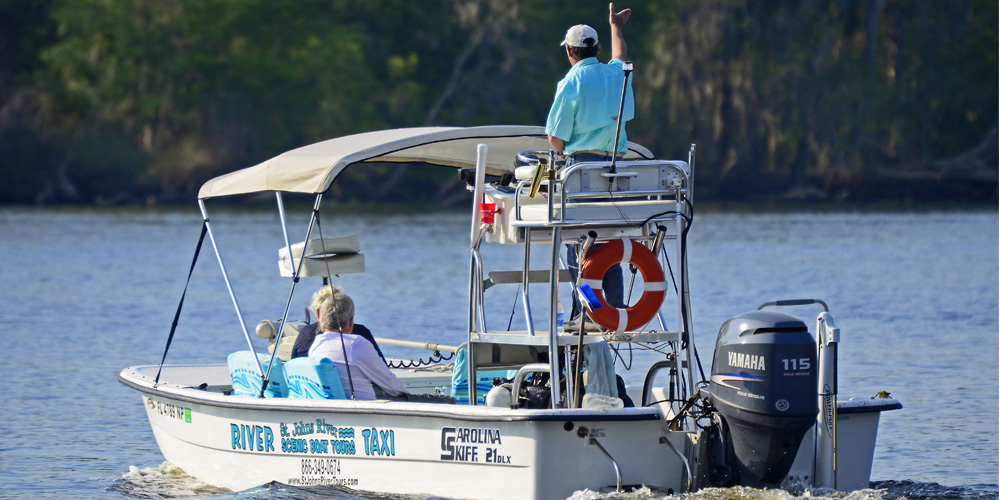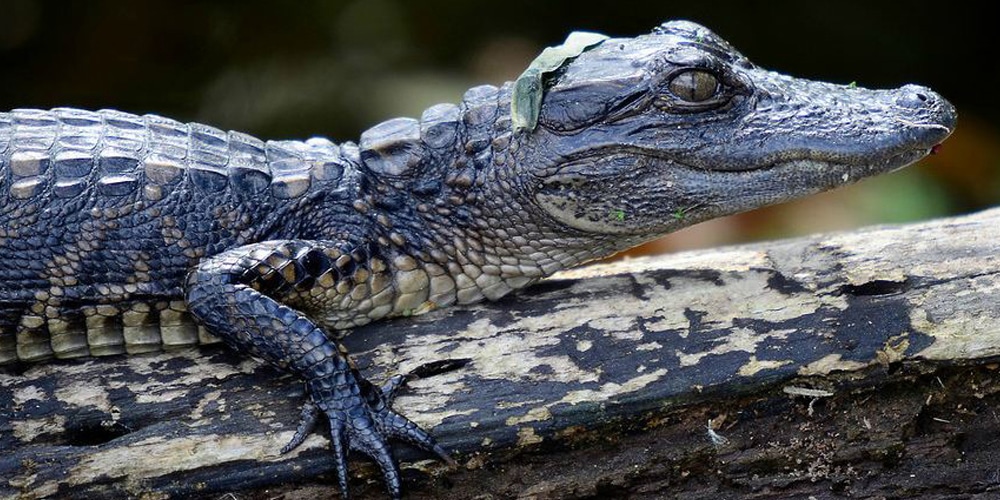Ask a Black Bear

Stories from people who have lived with the
Florida Black Bear Scenic Byway
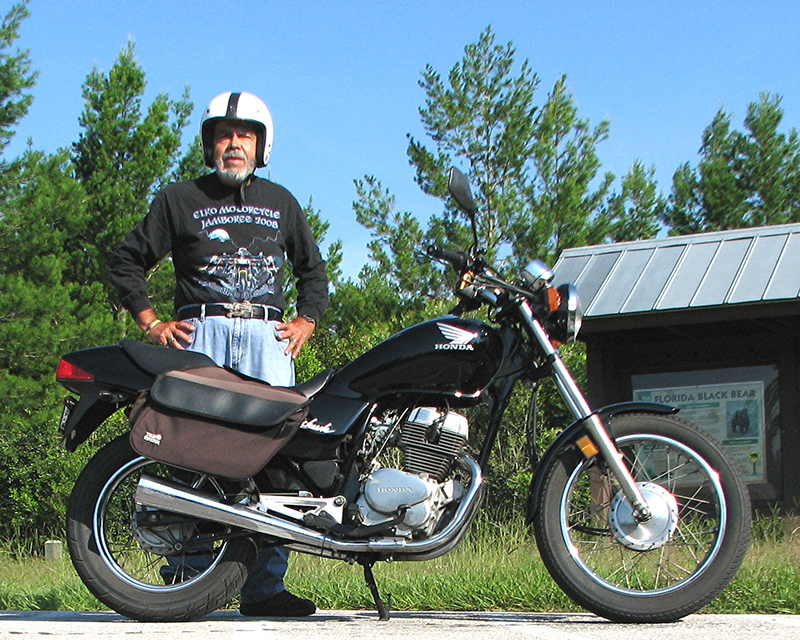
Riding Into Bear Country
by Tom Rose
“High on the mountain tell me what you see
Bear tracks bear tracks lookin’ back at me
Better get your rifle boy before it’s too late
Cause the bear’s got a little pig and headed through the gate
He’s big around the middle and he’s broad across the rump
Runnin’ ninety miles an hour takin’ thirty feet a jump
Ain’t never been caught he ain’t never been treed
And some folks say he looks a lot like me“
– From the song Ole Slew-Foot recorded by country singer Porter Wagoner, and written by Jay Webb
When I heard that the portion of State Road 40 that runs East from Silver Springs, through The Ocala National Forest to Ormond Beach, FL had been officially designated The Florida Black Bear Scenic Byway I knew that there would have to be a ride.
I have hunted, fished, camped, canoed, and motorcycled the area for over 50 years. Through all the growth and development that Florida has experienced, much of The Forest and its surroundings have remained unchanged, a natural wildlife habitat surrounded by Florida’s exploding population and development.
In addition to the main corridor of SR 40, the Byway includes loops on SR 19, County Rd. 445 and Forest Road 29 (43) to the St. Johns Ferry at Ft. Gates. Approval for National Byway Designation is expected in August 2009.
I’ll begin my ride in Umatilla, FL, motoring North on the 2 lane, well-maintained State Road 19. It is just 3 miles to Altoona where I top of the tank, the last of the gas stations for 30- to 40 miles depending on your route. Next is the little community of Pittman, which marks the beginning of The Forest and the Scenic Byway. It is also the location of the Pittman Visitor Center where maps and other Forest information are available.
It’s early morning and few vehicles are on the road. The stock mufflers on the Honda Nighthawk make the early morning ride almost silent, gliding along the ribbon of black asphalt that cuts through the dense green woods of The Ocala National Forest. Known locally as The Ocala or The Big Scrub, it consists of 383,000 acres and over 600 lakes, rivers, and springs.
The road is lined with the forest vegetation that makes The Ocala unique, small scrub oak and the world’s largest stand of sand pines thrive in the sandy soil.
The basic layout of the Florida Black Bear Scenic Byway is a cross so my ride will involve some backtracking. I’ll continue on 19 north, then West on SR 40 which is the main corridor of the Scenic Byway.
I am now headed for Silver Springs, one of Florida’s earliest tourist attractions, beginning around 1870 featuring river cruises and glass bottom boats. Silver Springs is a privately operated, naturally oriented attraction still featuring the beautiful springs and Silver River. It is well worth a visit if you have an extra day. There are a wide selection of motels, campgrounds, and restaurants nearby.
Along the way are numerous interesting stop offs including Juniper Springs, the Lake George Ranger Station, and the Oklawaha River. I’ve planned my trip as an all natural outdoor adventure tour, so I’m doubling back to my chosen camp site in The Forest at Juniper Springs. The campsites are located in a beautiful oak hammock, each site equipped with a fire ring, picnic table, lantern post, bar b-q grill, nearby rest rooms and showers. After checking in and setting up I head for the springs, a pool of crystal clear 72 degree water bubbling out of the earth at a rate of 8 million gallons per day! A dive into these magical waters is guaranteed to refresh body and spirit. I spend the rest of the afternoon on the nearby hiking trails.
As night falls on my Juniper campsite I take time to reflect on the newly designated Scenic Byway. The Florida Black Bear stands as the symbol for this unique roadway. Fittingly so, for the bear is the undisputed king here, Florida’s largest land animal, roaming the 383,000 acres of the Forest and surrounding land unchallenged. It is estimated that 1/3 of the state’s 3000 bears reside in the Ocala. His only enemy is the encroaching development that could wipe out his natural habitat. Bear hunting is banned in Florida. Some 25 bears die annually on the roads of The Ocala in vehicular encounters.
After a good rest and great night at the Juniper Campground I’m on my way again east on SR 40 and then North on SR 19 past Salt Springs to the northern terminus of the Byway just south of Palatka. Then back to Salt Springs for a bit of real backwoods adventure, taking Forest Road 29 (7 miles of dirt & gravel) through the forest to the Ft. Gates Ferry, where you and your motorcycle can get a ride across the St. Johns River for $5.00 (closed Tuesday). The crossing only takes 10 minutes, but it is an experience you’ll never forget. The ferry consists of a small barge pushed by a small tug boat. Ferry service was begun at Ft. Gates by the U.S. Army over 150 years ago.
Landing on the eastern shore of the river it’s on to Crescent City and south on US 17 to SR 40 and on to the eastern terminus at I95.
Then I double back, crossing the St. Johns again at Astor, then 445 South to Alexander Springs, then to SR 19 and back to the start/finish at Umatilla. It has been everything that I expected, and more. A great ride!
I hope that all of this can be preserved for my grandchildren and yours, for all future generations. The Scenic Byway designation can enhance the public awareness of this pristine wilderness, drawing supporters who will work for its protection and preservation. If I can take this ride and write about this great resource in a way that will expand the appreciation and understanding, then I will have paid back in a small way for all the enjoyment I’ve had in The Ocala over the years.
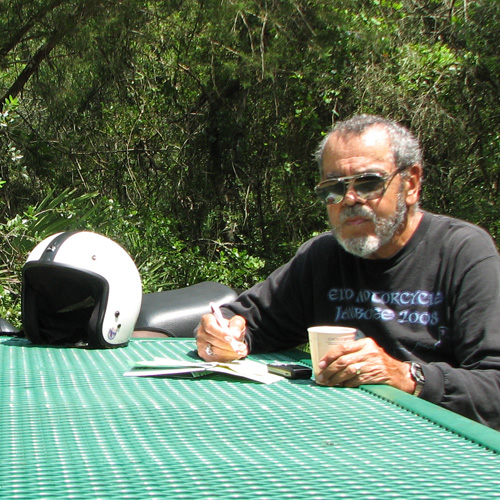
Tom Rose is a freelance journalist specializing in outdoor, adventure and motor sports stories. His work has appeared in Rider Magazine, Florida Wildlife, Outdoor Adventures, Motorcycle Classics, and many other national, regional, and local publications. Tom has been an active member of the Florida Black Bear Scenic Byway for 14 years and a regular contributor to the Byway Newsletter. http://tomrosejournalist.blogspot.com/
Tracking the Black Bear
by Cathy Connolly
Where are you most likely to see a Black Bear in Florida? The Florida Black Bear Scenic Byway runs right through the middle of the Ocala National Forest. The Ocala National Forest is home to more bears than any other area in the state of Florida. The Forest has approximately 1200 bears living in and around it. I have been fortunate with my job to encounter a great number of bears over the years. There is no reason why you shouldn’t be able to find where the bears are.
Many of the Forest roads cut off SR19 and SR40. They are dirt roads and are easy to access. The roads are identifiable by a brown sign with numbers. The best times to travel these roads are very early in the morning and just before dark. The bears are most active during these times. However, in the fall when they are eating constantly to store up for the cooler days ahead, you can spot them at all times of the day and night.
For the more adventurous person, you should get on one of the many trails and hike. One that I would recommend is the Florida trail. You can pick up the Florida trail at Alexander Springs, Juniper Springs, or Salt Springs. You never know what you may encounter. There are not only bears, but bobcats, foxes, deer, and many species of birds and reptiles. If you have never seen a bear in the wild, you are in for a treat. It is quite exciting to see these majestic animals roaming the land. I will never forget the first time I saw a bear in the woods near my home, which is very close to the Ocala Forest.
You do need to keep a few things in mind while hiking in bear territory. Try to avoid hiking alone, if possible. If you do encounter a bear, enjoy it from a distance (that is what zoom lenses are for). A sow with cubs will be very protective. Give them plenty of space. Most bear encounters in the forest are not threatening. The best advice is to be alert and never feed the bears or any wildlife.
Enjoy exploring the Florida Black Bear Scenic Byway. Take a walk on the wild side!
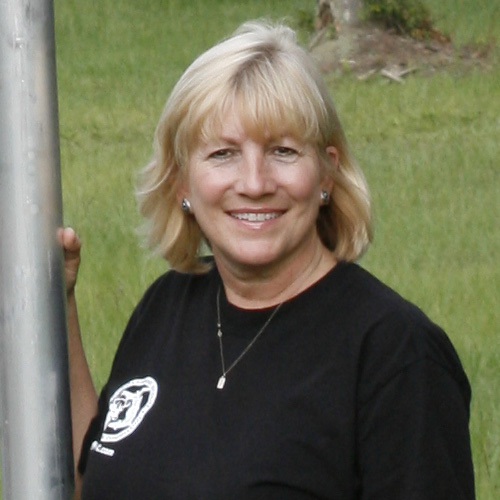
Cathy Speidel Connolly worked for the Florida Fish and Wildlife Conservation Commission in the Bear Management Program for 6 years. She was one of the first hired in the Bear Response Contractor program in 2001 and in 2009 was hired by FWC Bear Management. Cathy also acted as Secretary for the Florida Black Bear Scenic Byway CME and the Treasurer for over 15 years. She is a longtime member and volunteer for Defenders of Wildlife. Cathy also served on the Board of the Friends of the Florida National Wildlife refuge for 2 years.
Although she loves hiking around the woods here in Florida looking for Bears, she can also occasionally be spotted camping and hiking in Arizona searching for cougars. Cathy loves wildlife photography and one of her photographs appeared in the Florida Wildlife Magazine. Her Florida Alligator photo appeared in one of the FBBSB brochures.
The Smell of Hot Sand
by Rick Tonyan
What does hot sand smell like? It’s a sweet, somewhat musky, odor that radiates off sand after its baked in 90-degree-plus heat for a few days.
It’s hard to describe, but I know it when I smell it. To me, it smells like home.
I’ve spent most of my life in the sands of rural Florida. Even when I visited my maternal grandmother, who lived in a town, her house was off a sand street, so the smell stayed in my nostrils during the summer.
Maybe most people aren’t sensitive to that smell, but it kicks off a wave of nostalgia in me. It’s like a lot of folks who start thinking of childhood Thanksgiving dinners when they smell the turkey in an oven. Hot sand brings to my mind horseback riding, ball playing, livestock tending, and sundry other activities in the heat.
After spending most of my life in the Florida scrub, my senses respond differently than most people’s. The hooting of a great horned owl or the croaking of tree frogs relaxes me and puts me asleep rather than keeping me up at night.
I smile rather than feeling apprehensive at the sight of a gator swimming alongside my boat. Insect stings usually don’t bother me very much.
It’s not that I’m unique. Most of the people from the scrub react the same way. Our senses have adapted to their environments.
Maybe that’s why we like chitlins, hog jowls, calf brains, and other dishes that make urban dwellers and Yankees run screaming from the table. We also throw hot sauce on just about everything we eat. Maybe that’s because we like to balance out the heat outside with heat
inside ourselves.
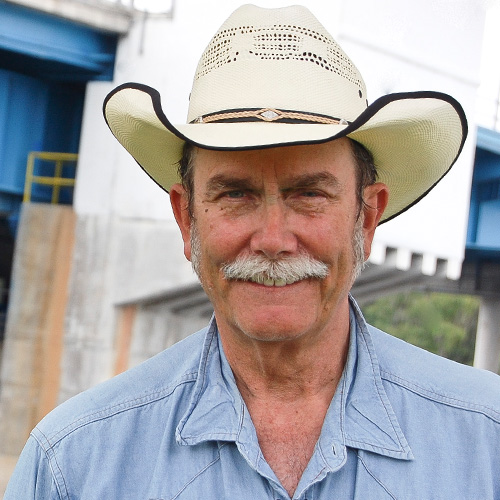
Rick Tonyan learned to ride and use a whip about the same time he learned to walk. A graduate of the University of Florida and a veteran of the U.S. Navy, he spent 17 years as a reporter for the Orlando Sentinel before turning to fiction.
His first novel, Guns of the Palmetto Plains has been in print since 1994. After writing the novel, he returned to journalism for magazines and newspapers in the North-Central
Florida area. He lives on a five-acre farm in DeLeon Springs, Fla.
The Barberville Pioneer Settlement
by Tony & Beth Erlich
This facility, known to locals as “The Settlement,” is one of our favorite spots along the extraordinary Florida Black Bear Scenic Byway. The Settlement embodies recreation and history, two of the seven intrinsic resources which every Florida scenic byway must have. Shortly after moving to Florida in the 80’s, we attended a festival there and fell in love with the place, became members and volunteers, and have enjoyed many good times since then.
The creative arts part of the formal name refers to the old-timey crafts taught and exhibited there, including blacksmithing, model railroading, wheelwrighting, potting, quilting, weaving, candle making, rushing, and caning chairs, and many others. When there’s not a formal class for these disciplines, there is often a group of folks practicing the craft. They offer many programs for kids and adults as part of their educational mission and school children arrive in buses to learn about the old-fashioned way of living.
What initially attracted us that November weekend in 1984 was the annual Fall Country Jamboree, with its country cooking made by volunteers in the Summer Kitchen, delicious sweet corn cooked in a huge cast-iron pot, and Florida folk music performed by groups from throughout the state. There were Native Americans in their Timucuan Village, cracker cowboys, sugarcane grinders, and, of course, clogging. We couldn’t take it all in, but we were hooked!
The Jamboree is the biggest and grandest of several festivals staged at The Settlement. There is also a smaller but similar Spring Frolic each April, an Old-Fashioned Christmas Remembered in December, and many other gatherings — good food, good music, and happy people at each one. We’ve volunteered at the gates for years and marvel to see that everyone leaving is smiling. Yes, everyone! And we smile as we wave goodbye and holler, “See you next year!”
There are 23 historic buildings on The Settlement’s 30-acre campus. The old Central Schoolhouse was the main educational facility in West Volusia for decades starting in 1918, until the growing local population called for more modern and less centralized schools. The school is now on the National Register of Historical Places.
The Underhill House, currently under restoration, is the oldest brick structure in Volusia County, built around 1879 from bricks made from clay dug along nearby Deep Creek. The train depot was moved there from Pearson, the United Methodist Church from Midway, the post office from Huntington, Wynn’s Country Store from Georgia, the Astor Bridge House from across the St. Johns River, and other buildings from locations throughout Florida.
In addition to scheduled activities, The Settlement is open for tours Monday through Saturday from 9 a.m. to 4 p.m. It’s located at 1776 Lightfoot Lane, Barberville, Florida. There is a great website at pioneersettlement.org., phone 386-749-2959.

Years ago, Beth and I visited Williamsburg in Virginia and Old Sturbridge Village in Massachusetts. Both are wonderful, larger, and more ambitious museums, but we found The Settlement is more participatory and full of laughter. If you’ve never been there, stop by. If it’s been years, head back — you won’t be sorry!
Beth & Tony have been members of the volunteer group that manages the Florida Black Bear Scenic Byway for six years. They became involved at the urging of the staff of The Settlement, a partner organization to the FBBSB. They helped in the drafting of the FBBSB Corridor Management Plan, which led to the state designation of the Byway as a Florida Scenic Byway 2008 and, subsequently, the application that led to the federal designation as a National Scenic Byway in 2009.
Note: This article was first written in 2012, and sadly, Beth passed away in 2013 (still missed by all). As of 2024, Tony is still on the FBBSB board.
Hidden Gem: The Fort Gates Ferry
by Tom Rose
There are so many great options for exploration of the Florida Black Bear Scenic Byway that it is difficult to zero in on just one. However, I do have a favorite that for me stands out. That would be just about any Byway ride that includes a crossing of the St. Johns River on the historic Ft. Gates Ferry. It’s ideal for elderly or handicapped travelers. You can travel this remote primitive area without even getting out of your car.
The Ft. Gates Ferry began operating almost 200 years ago to facilitate the river crossings of U.S. Army troops during the Seminole War. Originally the ferry operated manually by a cable/winch system. It evolved over the years to the present operation, which was set up in 1946, consisting of a barge capable of transporting 2 cars, up to 20 motorcycles and numerous bicycle and foot passengers. The power comes from a small tugboat (converted sailboat) powered by an Isuzu Diesel engine. It is Florida’s oldest continuously operated ferry. It is also the only privately owned and operated ferry in the Florida transportation system.
A good route is to approach the ferry from SR 19 at Salt Springs. It is 7 miles of dirt and gravel on Forest Roads 62 & 29 to the west side ferry landing. The road winds through a particularly beautiful remote section of the Ocala National Forest. It is an opportunity for some outstanding wildlife observation including deer, turkey, fox squirrel, scrub jay and black bear. Once you reach to ferry landing just pull up to the ramp and flash your head light. That is the signal that you want to be picked up. Be patient, within a few minutes you’ll see the ferry leave its base on the eastern side of the river and head your way.
The river is narrow here, less than ½ mile. You’ll enjoy crossing the mighty St. Johns at this pristine wilderness location. It is not unusual to see alligators, otters, turtles, and a variety of waterfowl. The 20-minute ferry ride will provide a lifetime memory. From the eastern landing it is just a couple of miles to US Hwy 17 and modern civilization.
You will have experienced a real Florida back country adventure. You’ll be able to tell your friends about a unique and different Florida, far removed from the standard Florida theme park vacation. Yes, you will have experienced the real Florida.
2024 Update:
The Ferry is not currently operating. Operations ceased in 2017 due to hurricane Irma damage to the landing docks. With extensive damage elsewhere in Central Florida repairs to the ferry were not a high priority. Bureaucratic red tape has delayed plans for repair and reopening. The ferry itself has been repaired. The East landing has been repaired. There is a budget in place for the West landing, awaiting coordination by Putnam County, FDOT, and the US Forest Service. It continues to be slow moving but hope remains that the problems will be solved. Ferry Captain Dale Jones believes there is a good chance the ferry will be up and running by September 2024. The best contact for updates is Captain Dale Jones (386) 467-2411 or the Punam County Board of County Commissioners (386) 329-0205

Tom Rose is a freelance journalist specializing in outdoor, adventure and motor sports stories. His work has appeared in Rider Magazine, Florida Wildlife, Outdoor Adventures, Motorcycle Classics, and many other national, regional, and local publications. Tom has been an active member of the Florida Black Bear Scenic Byway for 14 years and a regular contributor to the Byway Newsletter. http://tomrosejournalist.blogspot.com/
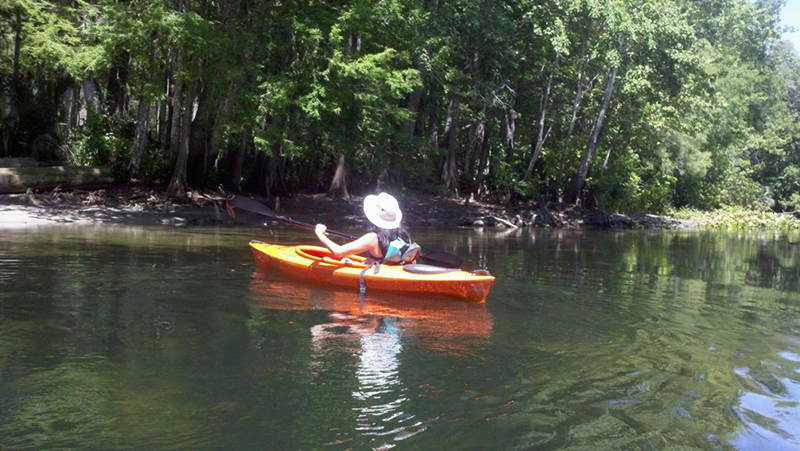
Kayaking on the FBBSB Waterways
by: Kristee Booth
Here are a few memories and pointers from my experience kayaking the Florida Black Bear Scenic Byway:
Juniper Springs: a great spring head with the Ocala National Forest amenities, the historic spring pump house, so beautiful to sunbathe or swim here. There’s a long boardwalk to traverse to put in the kayak/canoe. I do love this challenging and beautiful run. It has a variety of narrow winding passages and wider ones with sandbars and high banks as well. There is little downed tree removal so it is more challenging in a canoe to twist and turn around these potential natural obstacles. I’ve seen deer and alligator along the way- that is when the arguing couples aren’t too loud to scare them off. This trip can challenge a couple’s patience and relationship – be warned!
It isn’t rocket science to navigate this run, which is not recommended for beginners. Still, it takes patience and awareness because what is great about this run is also what makes it challenging: it has an amazingly beautiful canopy of trees winding down at you – but if you are not paying attention – you WILL get clocked in the head, as well as stuck on trees underwater if you are not looking all around the “obstacle course” of Juniper Springs Run.
Alexander Springs: is always a good run as it is always pretty, and it is less complex than Juniper. A better choice for little ones, perhaps. All these springs are great spot for bird and nature watching: I have seen gators, herons, cormorants out drying their wings, deer, osprey, hawks, and gators. A friendly dragonfly hitched a ride with me a while on one trip. Turtles haul themselves out onto downed trees to sun themselves. Cormorants are out on limbs drying their wingspan with the usual drama, and otters pop their heads up. The diversity of birds is truly endless in this neck of the woods.
Silver River-Ocklawaha Run:Starting in the Silver River State Park- they can be accommodating if one needs assistance as there is a looooong dirt path to hike to the put in spot for kayaks. The Park has a great, very informative Museum that is a “must see” stop. For the energetic paddler, you can paddle up to the springs attraction and won’t be disappointed. You can see manatees, all kinds of fish species, a variety of birds and possibly some raccoons as well as some of the movie props used on location at Silver Springs. The Silver Springs Rive run is stunning, lined with large trees, clear water you can see through, and some narrow passages to add spice to the trip. There is a possibility to see rhesus monkeys which, contrary to popular rumor, aren’t escapees from the Tarzan movie, but were intentionally released some years ago to attract tourists.
To paddle the Ocklawaha River one can come down from the Silver River or there are other put in points along the river. You can put in at Ray’s Wayside Park, which has a few amenities, and go south to the springhead or head north on the Ocklawaha to Gore’s Landing (this has some amenities). From Gore’s Landing, you can float up to the Outpost (this private business has camping facilities) and spend the night camping or continue your journey to investigate the old lock and dam system. I’ve always had a good time on this paddle trip and have participated in the Aquaholics Poker run for charity. It is yet another beautiful river to float on and enjoy the sights and sounds of the Florida woods. I even discovered one pullover spot on the Ocklawaha where I got a “fish pedicure and manicure”! People pay good money to have little fish nibble the dead skin off their feet and hands – it was a significant trend in 2011 – and I got a “wild” one for free!
There’s no end to the ways you can get close to nature on this byway.
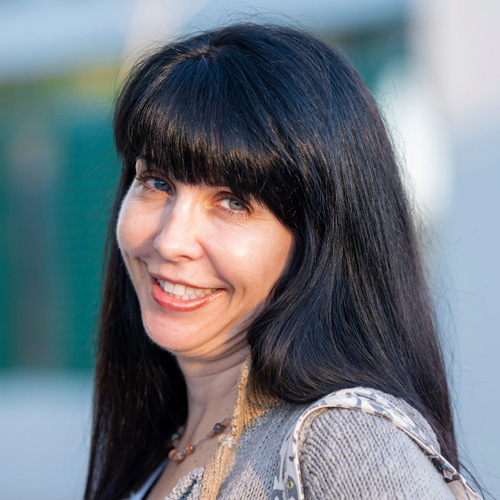
Kristee Booth is a wildlife biologist with the Florida Fish & Wildlife Conservation Commission (FWC). She has an undergraduate degree in Biology from WVU; MS degree in Ecology from FIT. She has been actively involved with the byway since its inception and is a current CME member.
This mountain mama travels the world to learn of the culture and history of the area and its people while enjoying those outdoor activities: hiking the Inca Trail to Machu Picchu, snorkeling with marine iguanas and sea lions in the Galapagos Islands, riding a camel up Mt. Sinai; horseback riding around the Great Pyramids, the jungles of Costa Rica or an active volcano in Ecuador, rambling through the ancient city of Troy or searching for the Loch Ness monster in Scotland, Kristee feels Florida and the FBBSB has as much beauty, history and adventure to offer as anywhere in the world.
Touring the St. Johns River
by Captain Ernie Brundage
As a resident and river tour operator on the Black Bear Scenic Byway, it would only go without saying that I think the St. Johns River is the jewel of the area. Steeped in Florida’s history, the river played an important role in the early development of Florida and was the home to a large community of pre-Columbian Indians.
I always reflect on the history when the early European settlers came to the Astor area, predating the pilgrims, and what it must have been like in the mid-1500s living in an untamed wilderness like the St. Johns. I can only imagine the early French and Spanish settlers meeting up with the Timucua and learning about the region and their culture.
Next, the American settlers were forging their lives out of a hostile area, with yellow fever, the Seminoles, and isolation. Then the steamboats arrived bringing them goods and winter visitors which must have made them feel closer to the civilized world.
These thoughts are always the opening of my narration on my tours. You can feel the wilderness as it was back then. Not much has changed on the river lakes and the tributaries. It’s common to see manatees feeding, Bald eagles soaring, and alligators resting along the banks of the St. Johns.
From the byway you can experience these settings by visiting several areas of interest like the settlement of Bluffton off SR 40 in the Lake George State Forest, or Silver Glen Springs, and a hike to Lake George on SR 19. You can rent a pontoon boat in Astor, or of course, you can take a river tour.

Note: Captain Ernie has since moved to North Carolina. His tours are no longer running, but there are always tours developing along the St. Johns River. Astor, where Capt. Ernie used to launch, still has marinas.
Exploring the Florida Black Bear Scenic Byway
by Chris Kincaid
I am frequently asked, “What is there to do around here?”… While Florida often brings visions of white beaches and blue ocean water, central Florida offers vast forest lands and extensive freshwater rivers, lakes, and wetland areas. It isn’t easy to pick a favorite, but here are a few suggestions:
The little town of Astor is located north of Orlando, between Silver Springs and Daytona Beach along Highway 40 on the St Johns River and Lake George. It is the gateway to many “Wild & Woolly” locations along the St. Johns River. There are plenty of campsites, RV parks, and rental cabins available. From a short overnighter to a “winter snowbird safari,” there are plenty of options for everyone. If you own a boat, you can quickly find yourself in the middle of nowhere. If you don’t have a boat, you can rent one, or you can take a short drive south for a guided tour out of DeLeon Springs State Park, on Spring Garden Run, on the Fountain of Youth Boat Tour, where you may see a variety of Florida’s famous wildlife.
In the spring, expect to see and hear alligators as they prepare for mating season. You will also hear the distinctive cry of the Limpkin (Aramus guarauna), a spectacular wading bird exclusive to the Southern U.S., Mexico, and Central and South America. Find them along the shore feeding on mussels and apple snails. As summer approaches, keep an eye on the sky, and you will see Swallow-tailed kites (Elanoides forficatus) as they migrate from Brazil to the second-largest nesting area in the U.S. here in Central Florida. Bald eagles are also very common as well as Ospreys. Manatees are a common spring and summer site along the river. You may even see them feeding on aquatic vegetation along the shore or hear them as they come to the surface to breathe. Look for large circular boils on the water in the creeks and near mats of shoreline vegetation.
If you want to get out into the forest, one of my favorite local hikes is located 12 miles west of Astor in the Ocala National Forest at Juniper Springs Recreation Area. The boardwalk hike is ADA-accessible and is suitable for all ages. This easy 0.8-mile trail (round trip) offers amazing views of the beginnings of Juniper Creek and ends at spectacular Fern Hammock Springs. Many smaller springs boil up through its sandy bottom along the way.
After your leisurely hike, take a dip in the 72 degree-year-round waters. It is a paradise in any season. Rent a canoe to float 7 miles to the Highway 19 takeout, and Juniper Springs staff will pick you up and bring you back. This journey will carry you through the Juniper Springs Wilderness area, where few dare travel. It is a beautiful, primeval place. Watch for alligators, bears, deer, and endless birding opportunities. Located approximately 30 miles from Ocala and 40 miles from Ormond Beach, this gem is an excellent getaway for the day or a long weekend!
Other local public lands include Lake George State Forest and Tiger Bay State Forest. Both locations offer inexpensive camping and extensive forests and wetlands. A Day use permit may be required for certain areas. Camping requires a reservation through the Florida Forest Service.
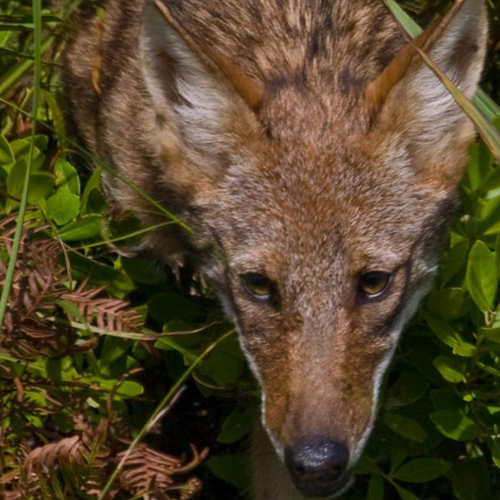
Chris was born in Tennessee and spent most of his childhood in Arkansas. He holds a master’s degree in Forest Resources from the University of Florida. Chris has worked with the Boy Scouts of America on their National Staff, from the Florida Keys to the mountains of New Mexico. He worked 15 years for the Arkansas State Park system as a Park Superintendent and as the Arkansas State Parks’ Trail Maintenance Supervisor. He started his Florida Career as the Recreation Coordinator for the Florida Forest Service’s Bunnell District and now works as an Urban Forester for Osceola County. He is an outdoor educator, former wild-land firefighter, avid sportsman, and accomplished nature photographer.
